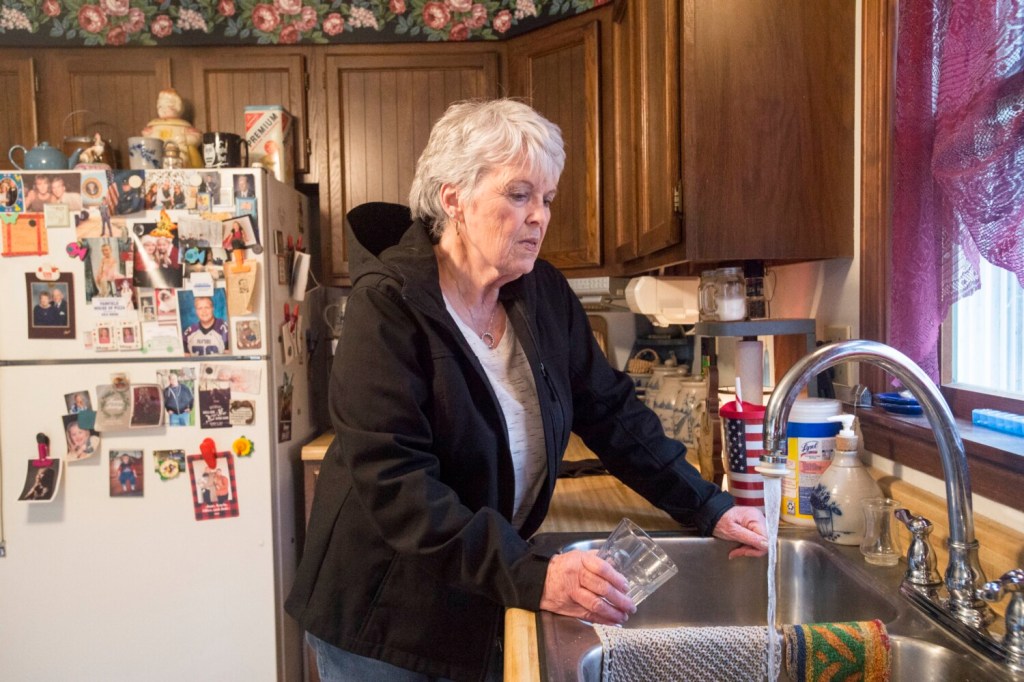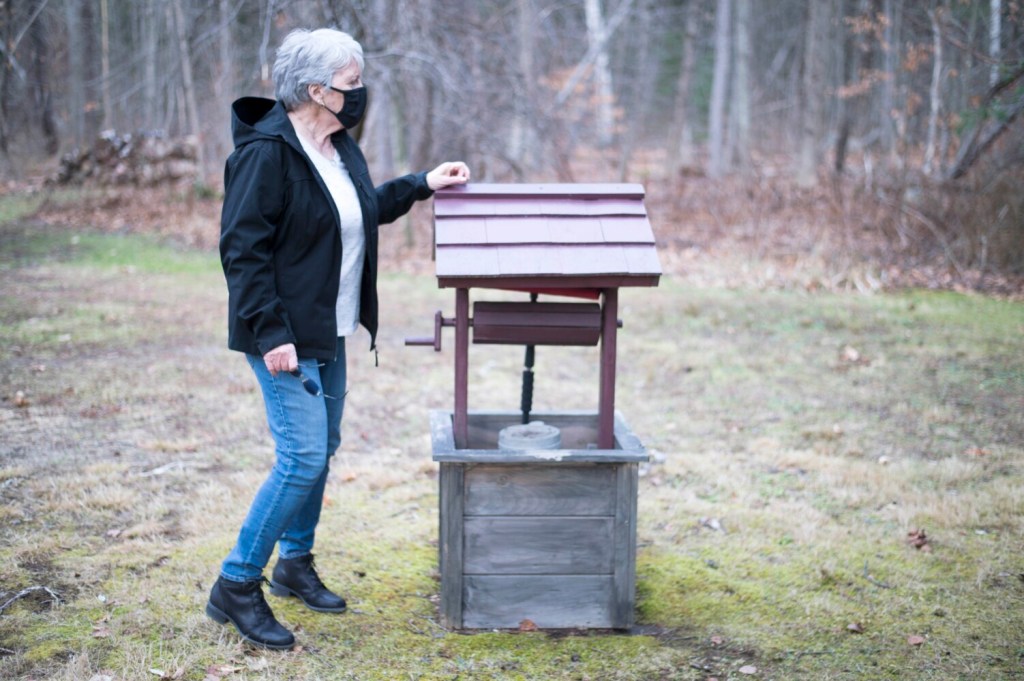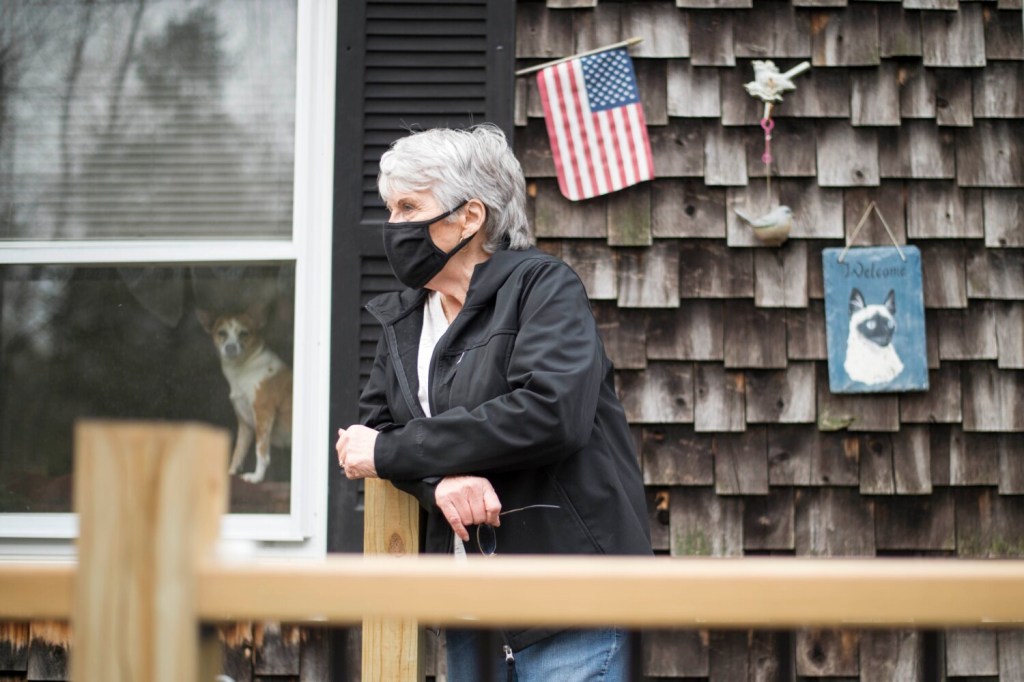FAIRFIELD — When Stana McLeod first learned that the Maine Department of Environmental Protection was testing farmland and wells in Fairfield for “forever chemicals,” she was instantly reminded of a situation that unfolded in the area more than 20 years ago.
The problem then, as now, involved the spreading of sludge.
In the 1970s and 1980s, area paper mills disposed of their waste materials in a Fairfield landfill that from McLeod’s grandmother’s house glowed in the dark, sometimes caught fire, smelled horrible and was connected to a cancer cluster. Now, the problem is more insidious, as the sludge spread on farm fields was viewed as beneficial, but its chemical makeup has poisoned at least 18 wells in the area, caused milk from dairy farms to be dumped and reduced residents to consuming bottled water as the investigation and testing of wells continues.
“I feel like we are doomed out here,” McLeod, 74, said in an interview earlier this month. She is frustrated that her efforts to bring the situation to the attention of those affected by the situation and those in a position to do something about it seem to be unheard.
McLeod has dedicated the last two months to reading about so-called PFAS — the forever chemicals — and contacting anyone who could help from the Fairfield town manager to state representatives. So far though, McLeod feels that her efforts are falling on deaf ears even as she attempts to organize community awareness and action.
History is repeating itself.
“I have a lot of information, but what good is it if nobody wants to listen?” McLeod said. “This is how I see it right now: My house and my property is worth nothing. You know I’m 74. I’ve had this house for 40 years, and I’m going to want to sell it in the next couple of years. However, I don’t see how it will ever happen. And I don’t see anybody that cares, I really don’t.”

McLeod was upset that the town didn’t notify residents as soon as the investigation began into the problems involving forever chemicals at the Tozier Dairy Farm in Fairfield.
Fairfield Town Manager Michelle Flewelling said she learned about the farm’s contamination and nearby well testing on Oct. 14 after speaking with David Burns, the director of the environmental protection department’s Bureau of Remediation and Waste Management.
The town has established a system to distribute water to those impacted by the contamination. Residents get 39 gallons of water per day, Flewelling said.
Last month, Poland Springs donated 960 gallons of water for the town to distribute to residents. The town of Skowhegan donated 900 gallons of water that was left over from the apparent contamination of its drinking water system that resulted in a recent no drink order.
McLeod is worried about people who have recently bought property in the area, “And they have no idea of any of this, no idea. It isn’t fair.”
McLeod is upset that the town has limited the number of people who can attend council meetings in person due to the COVID-19 pandemic and that the council meeting in November, where state officials addressed the contamination, was hard to follow over Zoom because the television was pointed away from where she sat.
“You can’t see the people,” McLeod said. “You can’t hear anything.”
During that meeting, attendees were given three minutes to ask questions, but due to time restraints, the council cut off the question-and-answer portion to move on with other business.
“I’m paying taxes to these people, and I’m getting nothing from them. No interest, no nothing,” McLeod said. “If the town can’t see that this is eventually going to affect them, they’re pretty blind.”

Stana McLeod pours a glass of water from her faucet at her home on Pirate Lane in Fairfield on Dec. 4. Michael G. Seamans/Morning Sentinel
She is skeptical of the use of carbon filters as a long-term solution for forever chemical contamination of drinking water.
“If my water is contaminated, from what I’ve always understood and from what I’ve researched, there’s no fix to this,” McLeod said. “And if there was, why do they call it forever chemicals?”
She has engaged a personal injury lawyer based out of Lewiston.
“Susan Faunce, she handles things like this, and they suggested that I, as people find out their wells are contaminated, I would have them call there and talk to her,” McLeod said. “They will keep a record of these people and then we can talk about the class action suit.”
CAUSED BY SLUDGE
The contamination at the Tozier Dairy Farm is suspected to have been caused by the spreading of municipal sludge, which is treated wastewater solids that can be used instead of fertilizer. The use of sludge, which is said to have organic benefits, is allowed in Maine and other states.
“The unfortunate thing is PFAS chemicals end up in our wastewater streams because of all of the products that contain PFOS and PFOA have been utilized for many decades,” Nancy McBrady, director of the state bureau of agriculture, said in an October interview. “So we have decades worth of this stuff that has been put down drains and ended up in our septic systems and ended up in our wastewater treatment systems.”
The land application of sludge was first licensed by environmental protection department as early as 1978, according to David Madore, acting deputy commissioner for DEP.

Cattle and barns are shown Oct. 27 at the Tozier Dairy Farm along Ohio Hill Road in Fairfield. Rich Abrahamson/Morning Sentinel file Buy this Photo
Madore said that records indicate that the Tozier Dairy Farm began the application of sludge from Kennebec Sanitary Treatment District around 1980, and it was last applied in 2003. The application of sludge and dewatered septage from Soil Preparation Inc. of Plymouth began around 2006 and last occurred in 2015.
In 1983, the Kennebec Sanitary Treatment District made sludge available to eight farmers in the area who spread it on approximately 450 acres of land, a treatment district official said at the time.
“Farmers are anxious to use the sludge on the farmland, he (the official) said, while the project saves the district much money,” the Morning Sentinel reported in 1983. “He said disposing of the sludge through spreading costs $60,000 yearly. If (the treatment district) were forced to rely on landfill burial, costs would be near $300,000 a year, he said.”
In 2016, sludge was found to have contaminated a century old dairy farm in Arundel after the Kennebunk, Kennebunkport and Wells Water District found elevated levels of PFAS in a well on the Stoneridge Farm property. The farm was forced to stop selling milk and had to kill off more than half of his herd.
In February, a test conducted by the Department of Agriculture, Conservation and Forestry found that milk from Tozier Dairy Farm on the Ohio Hill Road had levels of perfluorooctanesulfonic acid that were higher than the limit of 210 parts per trillion set by the state. Milk from the farm had levels of 12,700; 14,900 and 32,200 parts per trillion. The farm’s products have been pulled off shelves.
The Department of Environmental Protection has expanded the investigation and has begun testing private wells. So far, 18 wells in Fairfield have levels of per- and polyfluoroalkyl substances, PFOA and PFOS, that are higher than the 70 parts per trillion limit set by the U.S. Environmental Protection Agency.
PFAS were first introduced in the 1940s. They were used in consumer products, such as carpeting, fabric, clothing, food packaging, and pots and pans, and in firefighting foams used at airports, firefighting training facilities and military bases. Their bond is strong, and they do not break down easily in the environment or in the body.
Studies have shown exposure can cause health issues, such as elevated cholesterol, thyroid disease, damage to the liver and kidneys, adverse effects on fertility, and low birth weight. Other studies show links between PFAS and the elevated risk of certain cancers.

Stana McLeod stands by her well at her home on Pirate Lane in Fairfield on Dec. 4. Michael G. Seamans/Morning Sentinel
DUMPING SITES
When McLeod, 74, learned of the PFAS investigation, she was reminded of the time when it was suspected that illegal dumping of paper mill sludge might have had adverse effects on the land, water and residents in Fairfield.
In 1976, Central Maine Disposal Corporation built a landfill facility on land leased by William E. Hapworth on Middle Road.
When the disposal corporation was granted its original disposal permit, it was only for inert solid waste from the Somerset County paper mill owned by S.D. Warren. The state filed a suit against the disposal corporation in 1984, alleging that the firm violated state disposal laws by dumping “petroleum products, chemical drums, household refuse, office paper and metal junk” into the Middle Road landfill. The state alleged that Michael Wood, who owned and operated the disposal corporation at the time, dumped fly-ash from paper mills into property that wasn’t licensed for that purpose.
“The suit claims the dumping took place on Wood’s Fairfield Ridge Road property and the town’s municipal dump on the Green Road,” the Morning Sentinel reported in 1984.
Wood said that fly-ash and slacker rejects were covered under the terms of inert solid waste. Fly-ash is the waste from burning wood materials, and slack rejects were the waste from the pulp mills before the Somerset County plant installed new paper-making machines, Wood told the Morning Sentinel at the time.
On Nov. 25, 1981, Wood was granted “after the fact” permission from environmental protection department to dispose of fly ash from Scott Paper’s mill in Winslow. However, the state alleged that CMD had been dumping the material from the Winslow plant since March 1981.
According to the state’s calculations in 1984, 40,000 cubic yards per year of fly ash were dumped at the Middle Road landfill.
The lawsuit also claimed that the Middle Road landfill was a nuisance to nearby property owners.
During a Fairfield town council meeting on Feb. 6, 1980, abutting landowner Richard Mosher voiced his concerns about the site.
“Mosher said that continuous smoke from the burning at the dump had plagued his family periodically from the time the operation began,” the Morning Sentinel reported at the time. “He claimed that a family pet had received caustic burns from materials dumped at the site and as a trapper he had observed caustic burns on wild animals as well …
“Mosher also cited his concern for his water supply since in his own gravel pits, he had seen oil slicks and dead frogs. He suggested that contamination might go down into the water table.”
At the time, Wood denied burning materials at the site. “It’s one of the cleanest landfill operations in the area,” said Charles Cheeseman, a lawyer who represented Scott Paper at the meeting.
During this time, McLeod was working for the Fairfield Police Department and remembers getting a slew of complaints from residents about the dumping sites.
McLeod herself can recall what the Middle Road landfill looked like before it closed in 1993.
“My grandmother and my aunt lived over there on Ohio Hill Road, and it overlooks the field where this site was,” McLeod said this month. “And as wide as the field went, it was just lit glowing at night time … there were rusty barrels and the smell was horrible.”
McLeod provided further detail on the Facebook page she created in an effort to educate residents about the current PFAS investigation.
“Where the sludge was piled up it glowed at night and sometimes flamed, my family owns a house on Ohio Hill and we watched this every night,” McLeod wrote on the page. “Sometimes the fire department was called. There were barrels all over the field, sludge was slopped all over the road and vehicles were sliding in it. I worked at the police department and many complaints were made by citizens … there was also fly ash in the air constantly. Cars, etc. would be covered with this.”
Arsenic, methylene chloride, acetone, naphthalene and various petroleum based compounds had been identified in the soil and water samples taken from around the dump in the 1990s, the Morning Sentinel reported in 1999. Paper mill sludge deposited at the site contained dioxin, a cancer-causing agent, the Sentinel reported.
CANCER CLUSTER
In 1999, residents in the area became increasingly concerned about the lasting impact from the disposal corporation’s dumping of paper mill sludge after six young adults were found to have brain cancer.
From 1990 to 2000, the rates of brain cancer in the area were normal except in these six people who were between the ages of 15 and 44 years old.
According to a 2001 report from the Maine Cancer Registry, part of the Department of Health and Human Services, the cases were deemed a probable cluster for three reasons: the rate of brain cancer in this age group was five times what was expected; brain cancer is an uncommon cancer, particularly in this age group; and the high rate was statistically not very likely to be due to chance.
“If the state tries to wrap us all up in the brain-cancer thing, that makes me nervous,” Deanna LaBrie told the Morning Sentinel in 1999. “There is a lot of breast cancer, reproductive problems and tumors.”
LaBrie, who lived on Old Center Road, suffered from cervical cancer, breast cancer and lung cancer. She, like McLeod, called for a wider investigation to be conducted at the time.
In 2001, the cancer registry determined that two-thirds of the cluster had spent time on the Hapworth property, where the landfill was located.
“However, only one case reported spending time in the ash pits,” according to a study published Jan. 30, 2001. The study also found that all but one of the cluster cases were exposed to burning at the municipal dump on Green Road. “Because we did not interview a comparison group in this investigation, the results cannot support or rule out any factor as a cause,” the study read.

There has been no confirmed connection between the current contamination of PFAS in farmland and wells in Fairfield and the dumping of paper mill waste during the 1970s and 1980s.
“Our current investigation efforts in Central Maine are based on reviewing available records for licensed biosolids land application sites that were the largest receivers of sludge from the Kennebec Sanitary Treatment District (KSTD) facility in Waterville,” Madore said in an email Dec. 8.
“The Department is conducting preliminary screening assessments (limited soil sampling from licensed land application fields as well as a water sample from an on-site well if one exists) at these identified biosolids land application sites. … The potential for the waste sites along Middle and Green Road to be sources of PFAS contamination and therefore meriting further investigation will be evaluated at that time.”
Andy Smith, a toxicologist with the Maine Center for Disease Control and Prevention, said in an email Dec. 7 that there is no confirmed link between PFAS exposure and brain cancer, but added: “From our reading of the scientific literature, it appears the human evidence for an association between PFAS exposure and cancer is strongest for kidney and testicular cancer.”

Stana McLeod pours a glass of water from her faucet at her home on Pirate Lane in Fairfield on Dec. 4. Michael G. Seamans/Morning Sentinel
In the meantime, McLeod carries on and looks to organize awareness of the chemicals.
“When I think about my place here — I was a single mother, I built this house, I struggled and … struggled to keep this going,” she said. “I’ve lived in my house for 41 years. I’ve had family living here since the Great Depression. I really didn’t do this for myself and I didn’t before. I just care about people.”
Send questions/comments to the editors.








Comments are no longer available on this story